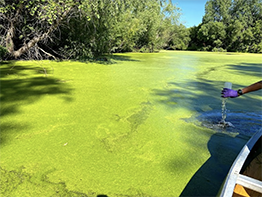
Retention ponds are an important tool for stormwater treatment. When they work, they sequester pollutants that would otherwise be washed into Minnesota’s waterways. However, these ponds lose functionality over time if they aren’t maintained properly. University of Minnesota researchers developed a powerful tool for cities and counties to manage retention ponds more cost-effectively.
Stormwater retention ponds are designed to settle pollutants into the sediment at the bottom of the pond. Older ponds, however, eventually fill up with sediment and lose their ability to sequester pollutants. In some cases—particularly when the pond has low levels of dissolved oxygen—phosphorus will re-release into the water. This, in turn, can cause harmful algae blooms. Traditionally, this has been dealt with by dredging, which is labor-intensive and costly.
After collecting field data at ponds across Minnesota and running the data through models, several effective treatment strategies emerged from the study. Treating a pond’s sediment with alum and iron filings (which capture mobile phosphate) proved to be especially cost-effective in older ponds that have already developed low-oxygen, high-phosphorous conditions.
Mechanical aeration is also effective under these conditions. Water bodies are typically kept oxygenated by the process of “wind mixing”—the wind roughens the water’s surface, allows oxygen transfer, and mixes temperature and chemical gradients. The researchers found that retention ponds tend to be poorly mixed by the wind (possibly because they are well-sheltered and have too little surface area for the wind to pick up speed), and the process needs to be helped along by underwater pumps.
Iron-enhanced sand filters were also found to be effective. However, the researchers recommend placing them only at the outflow point of the pond, since bordering the entire pond with a filter would quickly become cost-prohibitive.
In newer ponds, where the goal is prevention, the researchers recommend making alterations to the watershed itself. Installing infiltration practices and conducting street sweeping can catch phosphorus before it ever enters the pond.
The study was sponsored by the LRRB and MnDOT.
—Sophie Koch, MnLTAP freelancer
Learn more:
- Wet Pond Maintenance for Phosphorus Retention (LRRB/MnDOT, 2022)